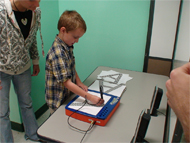Trace-Aid - A device to improve fine motor control among children with Autism
David Zilber, Elliot Greenwald
University of North Carolina at Chapel Hill
Abstract
The ability to write is a skill that is not only essential for natural progression in an academic setting, but is also a capability that requires proper development in order to optimize success in future relevant endeavors. However, for children with autism, traditional methods for developing this skill are less effective. Typically, the precursor to writing is the development of fine motor control within the dominant hand, and this can be accomplished via tracing. Even with the one-on-one, personalized instruction and positive reinforcement offered at the Mariposa School, a school for children with autism, the children lack motivation to advance their tracing ability.
The Trace-Aid device aims to supplement currently utilized forms of motivation with one that has been proven to be especially effective among children with autism: music. The device accomplishes this task by detecting whether the student is properly tracing over the designated area, and plays customizable music accordingly. This instant and desirable feedback is achieved by embedding a light-sensing photodiode in the tip of a custom-made pen that interfaces with microcontroller. The microcontroller determines if the pen is tracing over the desired area, and activates music from a built-in MP3 player. The user-interface maximizes both child-pleasing aesthetics and real-world functionality by incorporating a commercially made tracing toy for children and a custom made writing instrument whose dimensions are similar to traditionally-sized pens.
Keywords:
Autism, tracing, fine motor control, mp3
Problem Statement
The goal of our project was to create a device that would develop tracing ability and fine motor control while supplying a proven motivation in the form of pleasant music, which is played only during proper tracing behavior. By combining easily customizable music with instant feedback, the device will effectively teach and motivate the user to trace properly.
Design and Development
As stated earlier, the purpose of the device is to play music when the child is tracing properly. In our prototype design, a sensor was mounted in the tip of a pen, and the client used this pen to trace over a piece of paper with a large printed letter. The paper rested on top of a commercial light-bed. When the sensor was over the letter, the photodiode output was a low voltage, due to the black ink blocking out a significant amount of light. Accordingly, when the sensor was off of the letter (as would be the case during improper tracing), the sensor output increased, corresponding to the increased light detected from the light-bed. Therefore for low voltages output from the sensor, the device activated the musical feedback, and for high voltages, the device turned off the music. The prototype worked well but had several caveats.
If the tracing area was solid black, then the device would not be able to differentiate between a moving pen and a stationary pen within the tracing area, because both would cause a low voltage on the photodiode. Additionally, low light within the ambient environment would provide similar signals as the black tracing area. These issues could be resolved using an accelerometer to detect motion of the pen, and a complex system of thresholds to differentiate ambient light from the signal received over the black tracing area. However, a simpler solution was to make the tracing area consist of a checkerboard pattern (figure 3). As a result, when the user is tracing over the checkerboard, the signal from the photodiode is roughly sinusoidal. The microcontroller looks for a sinusoidal signal of a certain minimum frequency, and triggers the musical feedback accordingly.
All internal calculations are performed with a PIC 16F876 microcontroller (Microchip, Chandler AZ), which receives input from a simple photodiode embedded within a pen. When the proper signal is received, the microcontroller commands a Rogue Robotics uMP3 board (Toronto ON) to play an MP3 file, which is stored on an easily accessible SD card.
The device was built into a commercially available children’s tracing toy, the Elmer’s Paintastics Light Magic. The pen (figure 4) was custom built with the use of a rapid-prototyping fusion deposition modeler and other widely available parts.
3.5 mm stereo jacks are used to interface the pen with the microcontroller and also to allow an audio output (figure 5). The device is battery powered, portable, able to accommodate a standard “8 ½ x 11” piece of paper, yet portable enough to fit on a lap tray.
Once the Trace-Aid (Figure 1) is activated by toggling the main power switch, the user can immediately begin tracing. As long as the pen is held over the designated tracing area, music will be heard from an audio output. However, as soon as the pen leaves the desired tracing area, or the child decides to keep the pen still over the tracing area, the music abruptly stops, signaling that improper tracing techniques have been initiated.
In the event that the child completes a tracing session with satisfactory results, the instructor may opt to provide an additional reward by playing continuous music. This is accomplished via a ‘reward’ switch (figure 2), activated by the instructor when deemed necessary.
When the session is complete, the device is powered off via the main power switch.
Evaluation
 Figure 5. (Click for larger view)
Figure 5. (Click for larger view) The effectiveness of the Trace-Aid device was evaluated primarily through the supervisors and teachers at the Mariposa School for Children with Autism. It was determined that the device was immediately effective in that the child would quickly learn how to prolong the playback of music through proper tracing habits. There were no aversions to the checkerboard pattern, or any other aspect of the device. After a successful tracing session, the child expressed his joy when the reward switch was activated and music began to play indefinitely. One supervisor at the school said, “Thank you again for everything you've done to make this device for us. I believe you have included anything and everything we could have asked for and I think you should be proud to know that your hard work and time will affect the lives of these children in a positive way.”
Discussion and Conclusion
The device is a success and meets the original design specifications. The device plays music while the child traces properly and allows the instructor to continue providing positive feedback when the task has been completed properly. Furthermore, although the device requires a specialized pattern, we provide the teachers with simple instructions on how to overlay this pattern over any object they want to have traced. This gives the teachers the freedom to use any image obtained on a computer, be it a straight line, a letter, or an arbitrary shape.
During initial tests, it was immediately clear that the instant feedback and the motivational music were highly effective in increasing the child‘s attention; his tracing performance has improved very quickly. Through the use of music as positive reinforcement this device holds great potential to help encourage children with autism to trace properly. This is of course the first step in developing writing skills, thus improving their communicative skills.
Acknowledgements
Funding for this project was provided by National Science Foundation Grant #0453339. We would like to genuinely thank Richard Goldberg, Kevin Caves , Robert Dennis, and Steven Emanuel for their assistance in the development of the device. We would also like to thank Jacqueline Gottlieb, Christopher Wensil, and all the other instructors and students at the Mariposa School for their input.
Correspondence should be addressed to:
David Zilber
815 Tadlock Place
Matthews, NC 28105


